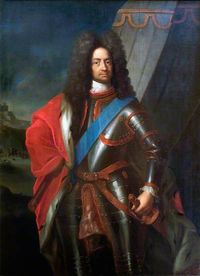Annotation:Elector of Hanover’s March (The): Difference between revisions
No edit summary |
No edit summary |
||
| Line 5: | Line 5: | ||
<br> | <br> | ||
<br> | <br> | ||
[[File:george1.jpg|200px|thumb|left|King George I]] | [[File:george1.jpg|200px|thumb|left|George Louis, Elector of Hanover. Later King George I of England ]] | ||
The Elector of Hanover refers to | The Elector of Hanover refers to George Louis (1660-1727), King of England and Ireland and concurrently ruler of the Duchy and Electorate of Brunswick-Lüneburg (Hanover). In 1708 he was ratified as prince-elector of Hanover (hence the title of the march). In 1714, a few years after publisher John Young's volume was issued, he was invited to assume the throne of England on the death of Queen Anne due to his faith; he was a Protestant, and although Roman Catholics were closer by blood to the throne, their religion was a barrier. | ||
<br> | <br> | ||
<br> | <br> | ||
Revision as of 06:31, 13 April 2014
Back to Elector of Hanover’s March (The)
ELECTOR OF HANOVER'S MARCH, THE. English, March (cut time). G Major. Standard tuning (fiddle). AAB. The tune and accompanying country dance appeared in all four editions of London publisher John Young's Second Volume of the Dancing Master (1710-1728). It was also published in Walsh & Hare's The Second Book of the Compleat Country Dancing-Master (1719).

The Elector of Hanover refers to George Louis (1660-1727), King of England and Ireland and concurrently ruler of the Duchy and Electorate of Brunswick-Lüneburg (Hanover). In 1708 he was ratified as prince-elector of Hanover (hence the title of the march). In 1714, a few years after publisher John Young's volume was issued, he was invited to assume the throne of England on the death of Queen Anne due to his faith; he was a Protestant, and although Roman Catholics were closer by blood to the throne, their religion was a barrier.
Source for notated version:
Printed sources: Young (The Second Volume of the Dancing Master, 1st edition), 1710; p. 160.
Recorded sources:
